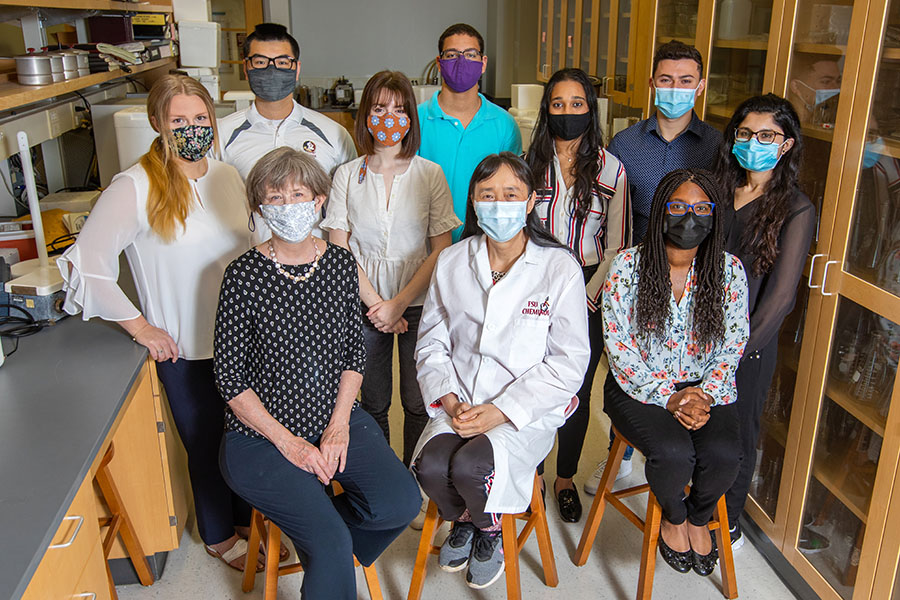
Pollution from miniscule pieces of plastic, or microplastics, have been a growing concern for scientists, public health advocates and environmentalists as these nondegradable items have increasingly made their way into waterways and even the air we breathe.
Now, a team of Florida State University researchers is looking at what inhalation and ingestion of these tiny particles can do to humans on the cellular level. Researchers found that exposure to microplastics for only a few days caused human lung cells to slow down their metabolism and growth, change shapes, and decluster so that gaps exist in what is typically a solid sheet of cells. The findings raise questions about the long-term effects of microplastics on human health, particularly for those who already have respiratory conditions.
Their research is published in Chemical Research in Toxicology.
“Plastics are very useful materials for daily life — they’re indispensable,” said FSU Professor of Chemistry and Biochemistry Qing-Xiang “Amy” Sang. “But as humans we want to live healthy lives, so we need to think of ways to minimize the potential adverse effects of plastics.”
As interest in microplastics grew, Sang and her team began thinking about how the inhalation and ingestion of these miniscule materials, simply by breathing, could affect human cells. Research specialist Joan Hare, doctoral students Kerestin Goodman and Timothy Hua, and former FSU graduate student Zahraa Khamis ultimately decided to focus their efforts on polystyrene, a type of plastic commonly used in disposable cutlery, takeout boxes and medical items such as test tubes or petri dishes.
“Polystyrene exists in many single-use items because it’s very sturdy,” Hare said. “But the very thing that makes it useful, makes it persist in the environment. And when those items are littered, it grinds into the soil and blows out into the air.”
The team exposed lung cells in a petri dish to small amounts of polystyrene at levels that are commonly found in the environment and found that though the plastic didn’t cause cell death, it caused some interesting changes. After only a few days, they found that the cell’s metabolic processes had slowed down, cell proliferation was inhibited, the shape of the cell morphed and the delustering had occurred. Additionally, the team found that the microplastic particles were uptaken by the cells and had formed a ring around the nucleus in the cell.
“Microplastics didn’t kill the cells, but the cells were definitely not acting normal,” Goodman said.
The research team said this study is a first step in understanding the effects of microplastics on human health, but that the findings really underscore previously raised concerns about the effects of microplastics, particularly for individuals with respiratory disorders like lung cancer, asthma, emphysema, pneumonia, fibrosis or chronic obstructive pulmonary disease (COPD).
The migration of the plastics toward the nucleus also raises interesting scientific questions for the team to consider going forward.
“We saw this attraction to the nucleus happening after only 24 hours and so now we really want to look at why are these pieces going there and what’s happening once they get there,” Goodman said.
Researchers cautioned that though they exposed the cells to common environmental levels of microplastics, they were directly exposed to the cells in a liquid solution. The process of breathing in and out could not be mimicked and could potentially affect the amount that an individual inhales and ingests.
“We don’t want to overstate the harmful effects of microplastics on human health,” Sang said. “The reason plastics are widely used is because they’re good materials for industry, construction, medical and research supplies, and consumer products. But there may be some long-term undesirable effects that could be especially detrimental to growing babies and people with lung diseases. We need to investigate so we have a better understanding of the potential cost to human health.”
Sang holds an endowed professorship in FSU’s College of Arts and Sciences created specifically for a talented faculty member working in cancer research. Endowed professorships from generous donors allow Florida State to attract and retain top faculty, like Sang. Funds from that professorship were used for this research.




